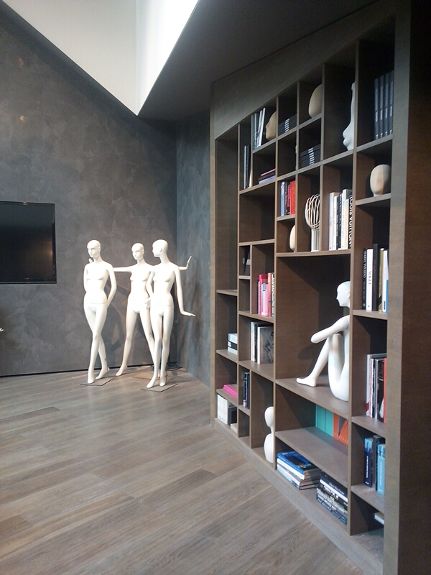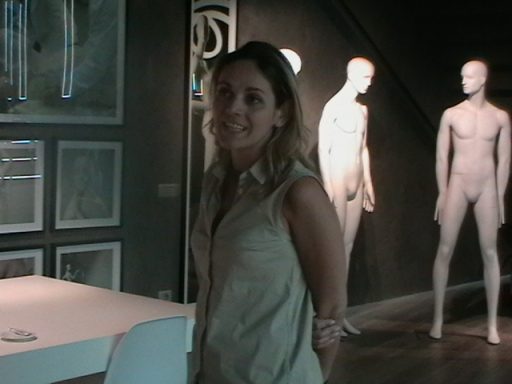Interview by ANNA & MARIA SCIACCA

Mannequins are exhibited in a variety of poses and expressions on a large stage with steps illuminated between the beams of the spotlights; they seem to welcome in the open space showroom of Bonaveri Milano. Sara Campanini showroom manager of Bonaveri Milano, which is an Italian excellence in the manufacturing of high fashion mannequins, presents us the showroom and the restyling of the Twiggy collection of the famous English brand Rootstein. In an intimate and fascinating ambiance, we see near a window overlooking the garden, other groups of mannequins in the elegance of their postures and in their dreaming and seductive looks, with also some pretty nice miniatures.

A stairway leads to the floor above, where there is a rooftop terrace is open during fashion events and parties. In the lounge area, some armchairs, a bar space, a bookcase, and a television furnish the showroom, while some Bonaveri sculptures and pictures on the walls, tell the birth of a mannequin.
During our interview with Sara Campanini, we discover the enchanting world of Bonaveri mannequins.
L’Idea Magazine: Do a man mannequin and a woman mannequin require a different kind of work?
Sara Campanini: The work is exactly the same.
L’Idea Magazine: Is there, perhaps, more fantasy in the creation of a female mannequin?
Sara Campanini: There is more fantasy, we can already see it in the variety of positions, these are all female positions; on a male mannequin, of course, we can’t utilize these poses.
L’Idea Magazine: So there is more variety in the gestures and expressiveness of the face?
Sara Campanini: No, the expressiveness of the face no, so having stylized or semi-realistic and realistic mannequins, it’s customizable on the face; more than anything else it is the creativity in the postures.
L’Idea Magazine: In an exhibition for Zara there were mannequins with eyelashes.
Sara Campanini: It is this collection that we see, but they had simply been applied false eyelashes.
L’Idea Magazine: The collection of mannequins with these eyelashes, seems to give something of intimist and meditative to their expressions…
Sara Campanini: A simply stylistic choice for this collection. The idea was born in this way, we wanted to make something more intimate, warmer, sweeter, and more graceful. We’ve always tried to come out with new collections every two or three years.
L’Idea Magazine: Are Bonaveri mannequins found in the window displays of worldwide boutiques and department stores?
Sara Campanini: Absolutely yes, Bonaveri or his distributors reach all over the world; everything starts from Renazzo, and then they’re shipped.
L’Idea Magazine: How long are the mannequins in the window displays utilized?
Sara Campanini: It depends on the type of the shop or brand of which we’re talking, there are brands that perhaps change their own image, it usually happens when there is a change of stylist and maybe they want to give a different image to the collection if we talk about multi-brands boutiques that exhibit a collection and maybe being without time, the mannequins that are utilized they can have a duration of twenty years. Depending on the type of client we interface with, Bonaveri also has a restoration service.
L’Idea Magazine: It would be interesting a museum of mannequins where we can see the various models.
Sara Campanini: Let’s say this museum is at our headquarters, let’s put it like this, in Italy, there isn’t this culture, it’s a world that not everyone can understand, can perceive for what it really is, which then basically the role is of not being visible, considering the placement where they are utilized, they are inside the shop windows where the main actor is the dress.
L’Idea Magazine: How is the working of a mannequin?
Sara Campanini: Approved the miniature, the sculptor creates, proposes the miniature again, the position at the desired height, at natural height, then from the natural height, a plaster cast is made, which helps us to create the mold for the production and the sculpture.
L’Idea Magazine: From the realistic mannequins to the stylized ones, which are the actual trends on the market?
Sara Campanini: There is a change of trend, a change of tastes because probably the realistic mannequin was too characteristic, was too strong also as an image, arriving at the stylized we say that the image has been cleaned, we have returned to the neutrality of the mannequin; now we have moved on to the sartorial, even more anonymous of the stylized.
L’Idea Magazine: How was the idea of the Bonaveri showroom born?
Sara Campanini: The atmosphere was to create a showroom as if it were a mannequin house with an entrance, kitchen, and living room. The showroom is utilized as the first meeting with stylists and clients to start a job, and then the clients move to the headquarters when there is the need to check, perhaps during the working of the model made by the sculptor.
L’Idea Magazine: The showroom also has a terrace…
Sara Campanini: The terrace is open during events and presentations of the collections.
L’Idea Magazine: The showroom ambiance with the mannequins and the spotlights set up in the ceiling is really wonderful!
Sara Campanini: Well, let’s say that we also like to say that we’re beautiful and good!
Gallery
THE GLAMOUR AND ELEGANCE OF BONAVERI MANNEQUINS
The beauty and the artistic style of Bonaveri mannequins can be admired in the worldwide window displays and department stores of international haute couture and prêt-à–porter collections and in the fashion exhibitions of famous stylists. At Renazzo di Cento, in the province of Ferrara, the Bonaveri society, which produces mannequins since 1950, it’s today guided by Andrea & Guido Bonaveri. In every Bonaveri collection, the mannequins are unique in their poses and expressions: Schläppi, Obsession, Aloof, Noble, Tribe, and Twiggy from the famous vintage Rootstein brand. The Bonaveri atelier has also realized a series of nice miniature mannequins. The mannequins can be realistic, stylized, abstract, or classic, while the Obsession collection’s mannequins with their colorful wigs they’re extravagant and dynamic, the Schläppi Aloof collection’s mannequins show elegance, with sophisticated femininity and sweetness in their expressions. The Bonaveri mannequins always represent the quality of “made in Italy” fashion.
We also paced some questions to Andrea Bonaveri on the authenticity of mannequins:
L’Idea Magazine: In cases of counterfeiting the originality of a mannequin, what are the characteristics from which the authenticity of a Bonaveri mannequin can be seen?
Andrea Bonaveri: Our copyright is registered in almost every market where we sell, in order to protect the complex of values, technology and aesthetics of our product, but it’s difficult to counteract the phenomenon of the copies that, in some cases, are bad reproductions and therefore easily recognizable, but sometimes, they are extremely faithful to the original. In these cases, it takes a careful and expert eye to examine the details, such as the base or the lines of the ankles that, usually, lose their harmony in size. It’s a sad phenomenon because it’s an appropriation of the artistic skills and of the whole creative process that is the basis of the realization of a mannequin.
L’Idea Magazine: As it is for the Barbie dolls who have the copyright Mattel brand, do the mannequins have a stamp that affirms their authenticity?
Andrea Bonaveri: Mannequins have the Bonaveri logo in their hidden parts. However, what allows us to prove the authenticity is the documentation in our possession which tells all the creative process, behind the copyright.
L’Idea Magazine: In the mannequin collectors’ market, what are the characteristics that are usually searched for in a mannequin?
Andrea Bonaveri: The collectors search for in the mannequin, elements that are the mirror of an epoch. In the silhouette, the stylistic elements governed by a historic period and that know how to describe it must emerge.


